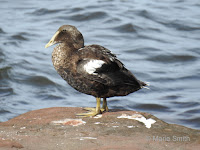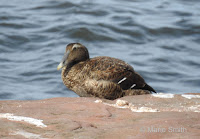COMMON EIDER
COMMON EIDER – (Somateria mollissima) – (See images below)
DESCRIPTION: The Common Eider drake (breeding male) is light grey-white on top and black under. The wing primaries are white and the other wing feathers are black. The head is black and the face is white. The bird’s bill has a wedge shape, and in the male it is greenish with a yellow tip. Females are mottled brown all over. The female bill is greenish but without a yellow tip. The legs and feet are grey. This is the largest duck in North America at around 65 cm (2 feet) long. There are many subspecies.
VOICE: https://www.xeno-canto.org/species/Somateria-mollissima
NAME: The English name ‘Eider’ would derive from Old Norse to mean ‘duck’. The Latin genus name ‘Somateria’ is from the ancient Greek and means ‘body’ and ‘wool’, in reference to the bird’s down. The Latin species name ‘mollissima’ means ‘very soft’, also in reference to the bird’s down.
HABITAT: Tundra islands when breeding, along salt water rocky coasts.
DIET: Molluscs are some of the favorite foods of common eiders, along with other invertebrates and crustaceans found on the ocean floor.
NESTING: Common eiders breed in large colonies and females will lay their eggs in different nests, not just their own. This is not viewed as parasitism but rather as part of their social structure. About a dozen green eggs are laid, incubated by the female. Ducklings can feed themselves from hatching, but the hen takes care of them.
DISTRIBUTION: The breeding range covers the coastal areas of the Arctic Ocean around the globe except Russia, and also the Nova Scotia coast on the Atlantic Ocean side. For the winter the ducks migrate along the coasts south of that range.
DISTRIBUTION MAP: https://en.wikipedia.org/wiki/Common_eider#/media/File:Somateria_mollissima_dis.png
ON PEI: Although not breeding on Prince Edward Island, the common eider is very present (common to very common) around the island throughout all seasons.
CONSERVATION: Hunted extensively for its prized down, the common eider was almost driven to extinction at some point in the past. Down harvesting has been practiced as far back as the Viking civilization.
The Common eider is currently listed as ‘near threatened’ by the IUCN due to population declines, which appear to be related to oil pollution in their habitat, over fishing of their prey, coming into conflict with aquaculture industries such as mussel farms, and unsustainable hunting (for sport or food) in some areas.
NOTES: As opposed to gulls who drop shells on hard surfaces to break them and eat their contents, eiders swallow them whole and use their powerful gizzards to crush the shells before excreting them.
Another example of a social structure in that species is when the females bring their ducklings to the water, where they can form large groups called ‘creches’.
Today there are eider ‘farms’ in Iceland, where wild common eiders are ‘encouraged’ to build their nests in specific areas and then after the chicks are gone, the down is harvested. Iceland is the main exporter of pure eider down, mainly to Japan for their futons. Because it is so rare and in high demand, a comforter or futon with pure eiderdown may sell for several thousand dollars.
SIMILAR SPECIES: King Eider
REFERENCES: http://www.hww.ca/en/wildlife/birds/blue-jay.html (Hinterland Who’s Who)
https://identify.whatbird.com/obj/1095/overview/Common_Eider.aspx
https://www.audubon.org/field-guide/bird/common-eider
https://www.borealbirds.org/bird/common-eider
https://www.mba-aom.ca/jsp/toc.jsp (Maritimes Breeding Bird Atlas)
Ducks Unlimited Canada (Common Eider)
http://www.npolar.no/en/species/common-eider.html (Noregian Polar Institute)
http://www.environmentandsociety.org/arcadia/attempts-establish-eider-farms-ussr-and-why-these-failed
https://en.wikipedia.org/wiki/Common_eider
DESCRIPTION: The Common Eider drake (breeding male) is light grey-white on top and black under. The wing primaries are white and the other wing feathers are black. The head is black and the face is white. The bird’s bill has a wedge shape, and in the male it is greenish with a yellow tip. Females are mottled brown all over. The female bill is greenish but without a yellow tip. The legs and feet are grey. This is the largest duck in North America at around 65 cm (2 feet) long. There are many subspecies.
VOICE: https://www.xeno-canto.org/species/Somateria-mollissima
NAME: The English name ‘Eider’ would derive from Old Norse to mean ‘duck’. The Latin genus name ‘Somateria’ is from the ancient Greek and means ‘body’ and ‘wool’, in reference to the bird’s down. The Latin species name ‘mollissima’ means ‘very soft’, also in reference to the bird’s down.
HABITAT: Tundra islands when breeding, along salt water rocky coasts.
DIET: Molluscs are some of the favorite foods of common eiders, along with other invertebrates and crustaceans found on the ocean floor.
NESTING: Common eiders breed in large colonies and females will lay their eggs in different nests, not just their own. This is not viewed as parasitism but rather as part of their social structure. About a dozen green eggs are laid, incubated by the female. Ducklings can feed themselves from hatching, but the hen takes care of them.
DISTRIBUTION: The breeding range covers the coastal areas of the Arctic Ocean around the globe except Russia, and also the Nova Scotia coast on the Atlantic Ocean side. For the winter the ducks migrate along the coasts south of that range.
DISTRIBUTION MAP: https://en.wikipedia.org/wiki/Common_eider#/media/File:Somateria_mollissima_dis.png
ON PEI: Although not breeding on Prince Edward Island, the common eider is very present (common to very common) around the island throughout all seasons.
CONSERVATION: Hunted extensively for its prized down, the common eider was almost driven to extinction at some point in the past. Down harvesting has been practiced as far back as the Viking civilization.
The Common eider is currently listed as ‘near threatened’ by the IUCN due to population declines, which appear to be related to oil pollution in their habitat, over fishing of their prey, coming into conflict with aquaculture industries such as mussel farms, and unsustainable hunting (for sport or food) in some areas.
NOTES: As opposed to gulls who drop shells on hard surfaces to break them and eat their contents, eiders swallow them whole and use their powerful gizzards to crush the shells before excreting them.
Another example of a social structure in that species is when the females bring their ducklings to the water, where they can form large groups called ‘creches’.
Today there are eider ‘farms’ in Iceland, where wild common eiders are ‘encouraged’ to build their nests in specific areas and then after the chicks are gone, the down is harvested. Iceland is the main exporter of pure eider down, mainly to Japan for their futons. Because it is so rare and in high demand, a comforter or futon with pure eiderdown may sell for several thousand dollars.
SIMILAR SPECIES: King Eider
REFERENCES: http://www.hww.ca/en/wildlife/birds/blue-jay.html (Hinterland Who’s Who)
https://identify.whatbird.com/obj/1095/overview/Common_Eider.aspx
https://www.audubon.org/field-guide/bird/common-eider
https://www.borealbirds.org/bird/common-eider
https://www.mba-aom.ca/jsp/toc.jsp (Maritimes Breeding Bird Atlas)
Ducks Unlimited Canada (Common Eider)
http://www.npolar.no/en/species/common-eider.html (Noregian Polar Institute)
http://www.environmentandsociety.org/arcadia/attempts-establish-eider-farms-ussr-and-why-these-failed
https://en.wikipedia.org/wiki/Common_eider
 |
| Common eider breeding male, England by Ross Elliott |
 |
| Common eider male in eclipse plumage Cavendish Beach, PEI, by Marie Smith |
 |
| Common eider female, by Marie Smith |